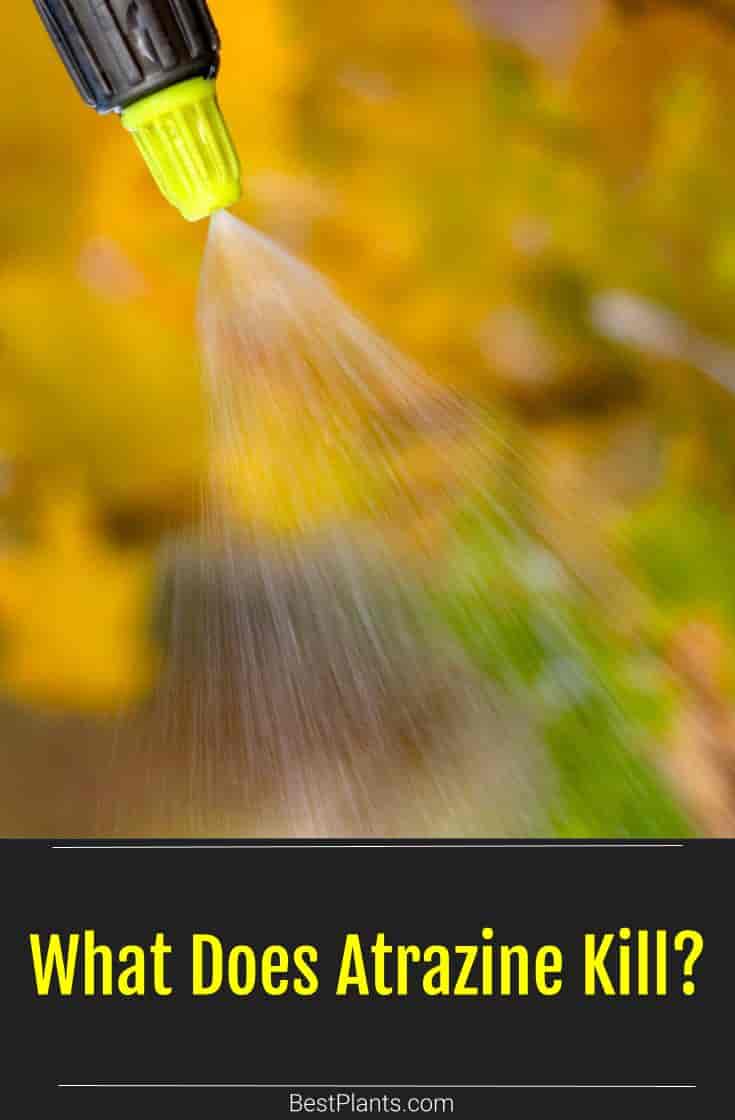Atrazine is a broad-spectrum, general-purpose herbicide that can be used as pre-emergent and post-emergent products.
It is effective on many weeds and can also be harmful to quite a few grasses and desirable plants.

It is a very widely used herbicide in farm settings, and it can be effectively used in lawn and garden settings as well.
You will often find it one of the active ingredients in many popular herbicides.
In this article, we discuss the efficacy of Atrazine and some of the concerns commonly associated with it.
Is Atrazine As Powerful As Roundup?
The fact is, this product is often able to eradicate weeds that even Roundup cannot quell.
One exception to this is crabgrass.
While Atrazine is somewhat effective against crabgrass, you’ll get better results using an herbicide that has been specially formulated to tackle this pesky weed.
What Does Atrazine Kill?
This product kills many different broadleaf weeds and pest grasses, such as:
- Mouse-ear Chickweed
- Western Wheatgrass
- Eastern Gamagrass
- Kentucky Bluegrass
- Narrowleaf Vetch
- Panicum Capillare
- Flora’s Paintbrush
- Annual Bluegrass
- Field Pennycress
- Florida Betony
- Japanese Brome
- Side-Oats Grama
- Barnyard Grass
- Lambsquarters
- Ground Cherry
- Annual Clovers
- Sand Lovegrass
- Yellow Foxtail
- Morning Glory
- Prickly Lettuce
- Buttonweed
- Fall Panicum
- Parsley Piert
- Jimsonweed
- Woodsorrel
- Witchgrass
- Wiregrass
- Wild Oats
- Quackgrass
- Poa Annua
- Bluegrama
- Indiangrass
- Chickweed
- Cockleburs
- Chickweed
- Cranesbill
- Cudweed
- Nightshade
- Switchgrass
- Swinecress
- Sunflower
- Spurweed
- Velvetleaf
- Moneywort
- Watergrass
- Junglerice
- Dichondra
- Lespedeza
- Knotweed
- Fireweed
- Bluestem
- Mustard
- Pigweed
- Purslane
- Ragweed
- Sandspur
- Sicklepod
- Smutgrass
- Foxtail
- Henbit
- Kochia
- Spurge
- Brome
These are just a partial list!
Much like Roundup, Atrazine has the potential to kill just about anything it touches.
On the downside, Atrazine kills pest grasses and lots of turfgrasses.
Therefore, it is only completely safe for Saint Augustine and Centipede grasses as a lawn herbicide.
If you have any other sort of grass, you should not broadcast this herbicide over your lawn.
You can use it as a focused, spot-on product, though.
Can You Use Atrazine In Your Flower And Vegetable Gardens?
This herbicide was initially formulated for use with food crops to be used in the vegetable garden.
However, it must be used carefully and only on weeds.
It will kill your veggies and your flowers just as quickly as it does weeds.
How Do You Use Atrazine?
It is best to use this product as a spot-on herbicide to deal with individual or small stands of weeds.
Follow packaging instructions closely. The label is the law.
When using, follow these tips:
- First, choose a warm, still day.
- Temperatures should be between 55° degrees Fahrenheit and 85° degrees Fahrenheit.
- Then, paint or spray the product carefully onto the unwanted plants you wish to target.
- Wear protective clothing and gear, and wash up promptly after using this product.
- Do not allow pets, children, or livestock to enter the treated area for several hours.
- The product should be dehydrated before any potential contact is made.
- It is best to apply a seasonal application two times annually in the late spring and the early autumn.
In this way, you will target both standing weeds and sprouting weed seeds.
Is Atrazine Dangerous?
Atrazine can be pretty dangerous when overused or used carelessly or inappropriately, including:
- Inhalation
- Ingestion
- Contact with eyes and skin
It can cause symptoms, such as:
- Mild irritation
- Redness
- Swelling
- Excessive salivation
- Weakness
- Labored breathing
- Nosebleeds.
For these reasons, you must follow packaging instructions and wear appropriate protective gear when using this product.
Long-term exposure can lead to liver damage and the development of various forms of cancer. [source]
If used in excess (e.g., broadcast widely), Atrazine will make its way into waterways with high potential to cause dangerous water contamination leading to health problems for wildlife and humans alike.
For this reason, its use has been banned in the European Union.
Like all herbicides, it is crucial to use Atrazine sparingly and carefully and in combination with other, more natural, weed control methods.
